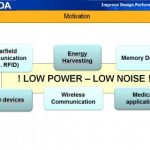You are currently viewing SemiWiki as a guest which gives you limited access to the site. To view blog comments and experience other SemiWiki features you must be a registered member. Registration is fast, simple, and absolutely free so please,
join our community today!
I have written about Sidense before, but last week at the TSMC Open Innovation Platform Forum, I had a chance to hear a talk by, and have lunch with Betina Hold Director of R&D at Sidense. Here is what I learned.
Sidense has been focusing on the growing market in what they like to call the smart connected universe. It is best to think… Read More
The motivations for having a data and process management system in place for semiconductor design have existed for a long time. I am reluctant to admit it, but I remember early efforts to do this back in the 80’s at Valid Logic. Cadence was also developing this capability in house through the early 90’s. Back then designs were much … Read More
Reusing design IP is crucial for competitiveness. The need for reuse occurs with new designs on the same process node as the original design, new designs at the same node but using a different PDK or foundry, or designs on a different process node – usually smaller. However, achieving effective IP reuse has always been a challenge.… Read More
As consumers, we take NAND flash memory for granted. It has worked its way into a vast array of products. These include USB drives, SD cards, wearables, IoT devices, tablets, phones and increasingly SSD’s for computer systems. From the outside the magic of flash memory seems quite simple, but we have to remember that this is a technology… Read More
Before we left for our 5 week trip to Europe I decided that I would need a real laptop computer on the road. I knew it would be a near necessity for booking hotels and making train reservations. Also, I would need to write emails and maybe even pay some online bills. I already have an iPad but really wanted to be able to run all my applications… Read More
Ever since I can remember, and I’ve been in EDA since the early 80’s, new process development has largely focused on the latest nodes. Trailing nodes were quickly put into support mode. New nodes benefited the most from static and dynamic voltage reduction efforts, as well as improvements in flows and performance. Only a small number… Read More
We hear a lot of talk about the internet improving our lives, but most of the time this translates into time spent on FaceBook, shopping on Amazon or other distractions. However, on our just completed trip to Europe I discovered how mobile internet connectivity can transform the experience of traveling.
At home when I drive places… Read More
Global semiconductor production capacity and its utilization level are key elements of the technology economy. During a panel at DAC in June Mentor Graphics posited that we are entering into a period where leading edge processes will be in high demand and also older nodes are seeing increasing demand due to Internet of Things designs… Read More
We have been hearing about low power for a long time. Fortunately, low power chip operation has come about through a large number of innovations. Key among these is clock gating, frequency and voltage scaling, managing leakage with lower threshold voltage, HKMG, and many other techniques. But we are entering the age of ultra low… Read More
When the term wearables is mentioned most people’s first thoughts go to devices like the Apple Watch, Fitbit Flex, or Nike Fuel Band. Wearables such as these solve first-world problems like how much exercise am I getting, or what is my heart rate. The developed world drives the development of new technology in most cases, and wearables… Read More













Jensen Huang Drops Donald Trump Truth Bomb on Joe Rogan Podcast